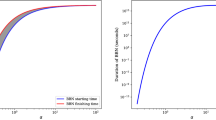Abstract
In this paper, we consider a holographic dark energy model driven by the gravitationally induced adiabatic matter creation with constant creation rate. It is assumed that the present accelerating stage is a consequence of the negative pressure describing the irreversible process of gravitational matter creation. Exact solutions are obtained to discuss the evolution of the universe. We obtain the best-fit values of the model parameters through MCMC method by the use of EMCEE python package on latest observational data. With the best-fit values, it is found that the universe shows transition from decelerated phase to accelerated phase. We carry out the diagnostic analysis to distinguish our model with other standard dark energy models. We also discuss the cosmography analysis of our model. We analyse the model by applying Akaike information criterion (AIC) and Bayesian information criterion (BIC) based on the penalization associated to the number of parameters. The results show that the model behaves quintessence like and approaches to \(\Lambda \)CDM model in late time.












Similar content being viewed by others
References
Abramo, L.R.W., Lima, J.A.S.: Class. Quantum Gravity 13, 2953 (1996)
Ade, P.A.R., et al.: Astron. Astrophys. 571, A16 (2014)
Ade, P.A.R., et al.: Astron. Astrophys. 594, 13 (2016)
Akaike, H.: IEEE Trans. Autom. Control 19, 716 (1974)
Alam, U., et al.: Mon. Not. R. Astron. Soc. 344, 1057 (2003)
Alcaniz, J.S., Lima, J.A.S.: Astron. Astrophys. 349, 729 (1999)
Anderson, L., et al.: Mon. Not. R. Astron. Soc. 441, 24 (2014)
Betoule, M., et al.: Astron. Astrophys. 568, A22 (2014)
Beutler, F., et al.: Mon. Not. R. Astron. Soc. 416, 3017 (2011)
Blake, C., et al.: Mon. Not. R. Astron. Soc. 425, 405 (2012)
Calvao, M.O., Lima, J.A.S., Waga, I.: Phys. Lett. A 162, 233 (1992)
Cao, S.L., et al.: Eur. Phys. J. C 78, 170 (2018)
Cardenas, V.H.: Eur. Phys. J. C 72, 2149 (2012)
Chen, B., et al.: Nucl. Phys. B 774, 256 (2007)
Cohen, A., Kaplan, D., Nelson, A.: Phys. Rev. Lett. 82, 4971 (1999)
de Haro, J., Pan, S.: Class. Quantum Gravity 33, 165007 (2016)
dos Santos, M.V., Reis, R.R.R., Waga, I.: J. Cosmol. Astropart. Phys. 02, 066 (2016)
Feng, C.J., Li, X.Z.: Phys. Lett. B 680, 355 (2009)
Feng, C., et al.: J. Cosmol. Astropart. Phys. 0709, 005 (2007)
Foreman-Mackey, D., et al.: Publ. Astron. Soc. Pac. 125, 306 (2013)
Gunzig, E., Gehenian, J., Prigogine, I.: Nature 330, 621 (1983)
Gunzig, E., Maartens, R., Nesteruk, A.V.: Class. Quantum Gravity 15, 923 (1998)
Hinshaw, G., et al.: Astrophys. J. Suppl. Ser. 208, 19 (2013)
Hsu, S.D.H.: Phys. Lett. B 594, 13 (2004)
Huang, Q.G., Li, M.: J. Cosmol. Astropart. Phys. 08, 013 (2004)
Komatsu, E., et al.: Astrophys. J. 192, 18 (2011)
Li, M.: Phys. Lett. B 603, 1 (2004)
Li, M., Li, X.D., Wang, S., Zhang, X.: J. Cosmol. Astropart. Phys. 0906, 036 (2009)
Li, M., et al.: J. Cosmol. Astropart. Phys. 09, 021 (2013)
Liddle, A.R.: Mon. Not. R. Astron. Soc. 377, L74 (2007)
Lima, J.A.S., Germano, A.S.: Phys. Lett. A 170, 373 (1992)
Lima, J.A.S., Calvao, M.O., Waga, I.: Cosmology, Thermodynamics and Matter Creation, vol. 317. World Scientific, Singapore (1991)
Lima, J.A.S., Germano, A.S., Abramo, L.R.W.: Phys. Rev. D 53, 4287 (1996)
Lima, J.A.S., Silva, F.E., Santos, R.C.: Class. Quantum Gravity 25, 205006 (2008)
Lima, J.A.S., et al.: J. Cosmol. Astropart. Phys. 10, 042 (2014)
Luongo, O.: Adv. High Energy Phys. 2017, 1424503 (2017)
Malekjani, M., et al.: Phys. Rev. D 98, 063533 (2018)
Nunes, R.C., Pavon, D.: Phys. Rev. D 91, 063526 (2015)
Padmanabhan, T.: Phys. Rep. 380, 235 (2003)
Padmanabhan, N., et al.: Mon. Not. R. Astron. Soc. 427, 2132 (2012)
Pan, S., Chakraborty, S.: Adv. High Energy Phys. 201, 654025 (2015)
Pan, S., et al.: Mon. Not. R. Astron. Soc. 460, 1445 (2016)
Pan, S., et al.: Int. J. Geom. Methods Mod. Phys. 15, 1850042 (2018)
Peebles, P.J.E., Ratra, B.: Rev. Mod. Phys. 75, 559 (2003)
Perlmutter, S., et al.: Astrophys. J. 517, 565 (1999)
Prigogine, I., et al.: Proc. Natl. Acad. Sci. USA 85, 7428 (1988)
Prigogine, I., et al.: Gen. Relativ. Gravit. 21, 8 (1989)
Ramos, R.O., et al.: Phys. Rev. D 89, 083524 (2014)
Riess, A.G., et al.: Astron. J. 116, 1009 (1998)
Sahni, V., Starobinsky, A.A.: Int. J. Mod. Phys. 9, 373 (2000)
Sahni, V., et al.: JETP Lett. 77, 201 (2003)
Sahni, V., Shaleloo, A., Starobinsky, A.A.: Phys. Rev. D 78, 103502 (2008)
Salzano, V., et al.: Mod. Phys. Lett. A 29, 145008 (2014)
Sanchez, A.G., et al.: Mon. Not. R. Astron. Soc. 425, 415 (2012)
Schwarz, G.: Ann. Stat. 6, 461 (1978)
Singh, C.P., Kaur, S.: Phys. Rev. D 100, 084057 (2019)
Steigman, G., Santos, R.C., Lima, J.A.S.: J. Cosmol. Astropart. Phys. 06, 033 (2009)
Susskind, L.: J. Math. Phys. 36, 6377 (1995)
’t Hooft, G.: (1993). arXiv:gr-qc/9310026
Visser, M.: Class. Quantum Gravity 21, 2603 (2004)
Visser, M.: Class. Quantum Gravity 37, 1541 (2005)
Weinberg, S.: Rev. Mod. Phys. 61, 1 (1989)
Zhang, X., Wu, F.Q.: Phys. Rev. D 72, 043524 (2005)
Acknowledgements
The data fitting is based on the publicly available EMCEE package, a Markov Chain Monte Carlo code. The authors express their sincere thanks to the anonymous reviewer for constructive comments/suggestions which helped us to improve the original manuscript significantly. A. K. would like to thank University Grant Commission, New Delhi for providing Senior Research Fellowship under UGC-NET Scholarship.
Author information
Authors and Affiliations
Corresponding author
Additional information
Publisher’s Note
Springer Nature remains neutral with regard to jurisdictional claims in published maps and institutional affiliations.
Rights and permissions
About this article
Cite this article
Kumar, A., Singh, C.P. Observational constraints on holographic dark energy model with matter creation. Astrophys Space Sci 365, 84 (2020). https://doi.org/10.1007/s10509-020-03799-1
Received:
Accepted:
Published:
DOI: https://doi.org/10.1007/s10509-020-03799-1




